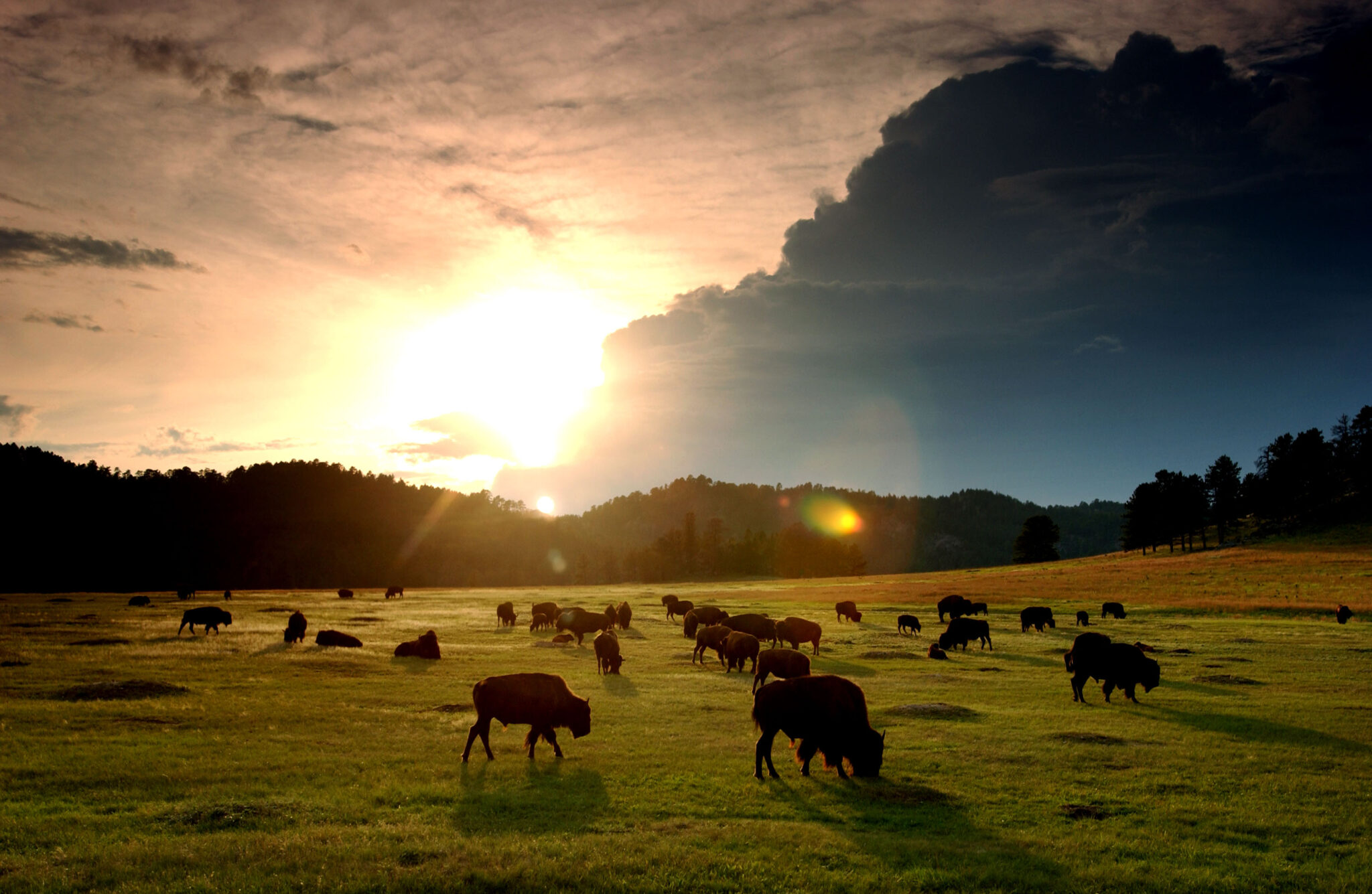 The sun sets behind a herd of bison in Wind Cave National Park, Aug. 14, 2001 in the southern Black Hills of South Dakota. A new study shows that restoring large populations of bison and other animals would speed up biological carbon pumps that take carbon dioxide out of the air and store it in a form that doesn't harm the climate. Credit: David McNew/Getty Images
The sun sets behind a herd of bison in Wind Cave National Park, Aug. 14, 2001 in the southern Black Hills of South Dakota. A new study shows that restoring large populations of bison and other animals would speed up biological carbon pumps that take carbon dioxide out of the air and store it in a form that doesn't harm the climate. Credit: David McNew/Getty ImagesAn international team of scientists focused the study on marine fish, whales, sharks, gray wolves, wildebeest, sea otters, musk oxen, African forest elephants and American bison as species, or groups of species, that accelerate the carbon cycle. Collectively, they “could facilitate the additional capture” of almost 500 million tons of CO2 by 2100, which would be a big step toward preventing long-term planetary heating of more than 1.5 degrees Celsius, the authors wrote in Nature.
Recent global climate reports and guidelines on carbon dioxide removal from the Intergovernmental Panel on Climate Change and other groups of scientists have often overlooked the multiplier effect of animals as a climate benefit, said lead author Oswald Schmitz, professor of population and community ecology at the Yale School of the Environment.
“I think a lot of people have always imagined that animals are so rare,” he said. “So it’s presumed that animals don’t matter, that they don’t have enough biomass to hold much carbon, let alone cycle it into the soil.”
But those species have an “outsized impact on ecosystems by virtue of changing what the bigger pools do,” he said. “And when you start looking at the numbers, the multiplier effects are backed by good science.”
A recent study in the western United States, for example, showed how restoring far-ranging populations of wolves and beavers would create ecosystems that capture more CO2 and also make landscapes more resilient to global warming impacts like extreme flooding, heat and drought.
Beaver dams create giant biological landscape sponges that can absorb CO2. Overall, global wetlands restoration will play a key role in reaching climate targets, according to the Intergovernmental Panel on Climate Change report.
Beaver ponds and healthy wetlands also retain flood water and release it slowly during dry times. When wolves are about, they help vegetation spread outward from the beaver ponds by checking the population of hungry deer or elk that eat all new growth.
And other research shows how protected forest habitats warm more slowly than the average increase of land temperatures.
Oregon State University ecologist William Ripple, lead author of the paper on rewilding the West with wolves and beavers, said most climate mitigation scenarios rely on “unproven carbon capture technologies.”
The new paper, he said, “supports the growing call to focus on natural processes rather than mostly unproven technologies to capture carbon and mitigate climate change. It shines new light on how we could benefit from conserving many types of wild animals for carbon capture.”
Climate and Biodiversity Are ‘Intertwined’
Those wild animals include fish in the sea, where our understanding of biological carbon pumps is quickly expanding, said co-author Fabio Berzaghi, a researcher at the World Maritime University in Sweden.
“Initially we were thinking that the main drivers in the biological carbon pump are mostly phytoplankton and zooplankton, so the bottom of the trophic web,” he said. “But now we know all marine life contributes to this process, especially mesopelagic fish, which are a huge part of the biomass in the ocean.”
Mesopelagic fish, as the most numerous vertebrates on Earth, populate the middle depths of the ocean, at the fringe of light penetration, but rise up in a great diurnal migration to feed on plankton near the surface, then diving back down and dispersing sinking fecal pellets that end up as CO2-storing sediment.
“Some scientists might say the biological carbon pump is just a small part of the Earth system,” he said. “But we are dealing with two extremely complex and intertwined problems: climate change and biodiversity loss. And, you know, even if it’s just 5 percent of the contribution to global carbon sequestration, we need to preserve these mechanisms to work as optimally as possible.”
To paint a global picture, he said the research team scoured studies from around the world that document the specific role of specific species in the carbon cycle and climate system.
“We wanted to put them all together to get a more global perspective,” he said. “We’re discovering more and more how different animals are actually modifying their ecosystems and the environment in ways that capture more carbon.”
Much Lost, Much to Be Gained
One way to understand how critical it is to rebuild carbon-capturing ecosystems is to consider what’s already been lost, said co-author Magnus Sylvén, an ecologist, and co-director of the Global Rewilding Alliance, a conservation advocacy group.
He said a 2021 research paper estimated that only about 3 percent of the Earth remains fully ecologically functional since human interventions started disrupting ecosystems, which, he said, “an interesting perspective in terms of what we have lost over these centuries by degrading the planet.”
Sylvén said he thinks scientists have deeply underestimated the climate impacts of that degradation, and that the new research shows how much could be restored on a time scale that matters for reaching global climate policy goals by 2100.
“If you start to restore, and have things like no-take zones in marine areas, or restoring some terrestrial ecosystems, it can happen very quickly,” he said. “In 10 or 20 years we can get a really significant comeback of wildlife, with benefits for climate mitigation and biodiversity and resilience.”